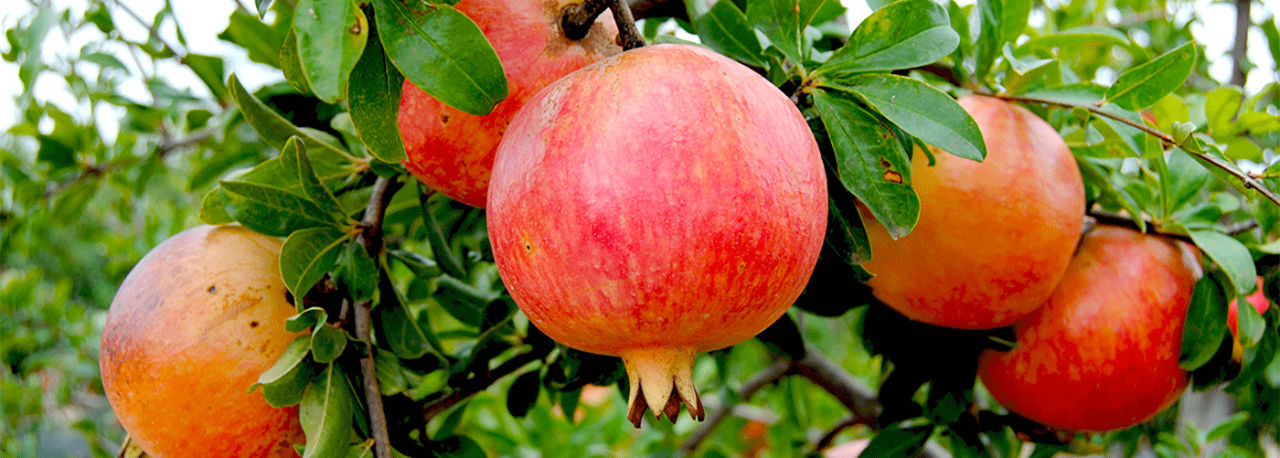.png.transform/rendition-xs/image_image%20(1).png)
Granada de Elche PDO
‘Granada Mollar de Elche’/‘Granada de Elche’ is the fruit of the Mollar de Elche variety of the species Punica granatum L., classes Extra and I as defined in the Codex Standard for pomegranates. The product is characterised by its acid-sugar balance, creamy yellow to red outer skin and the anthocyanin content of the arils, which gives them a deep pink to red colour.
Tasting notes
The pulp is moderately astringent and tastes very sweet, while the seeds are mild.
Other notes
1. Morphological- Shape of the fruit: round; the inside is divided into lobes and within these are the seeds (arils). The outer skin is of fine to medium thickness, smooth and shiny.
- Colour: from cream to deep red on the outside. The seeds are covered with a juicy pulp ranging from deep pink to red in colour.
2. Physical and chemical:
- Degrees Brix: minimum 14°
- Acidity (% citric acid): minimum 0,18 and maximum 0,24
- Maturity index (Brix/acidity ratio): minimum 60 and maximum 903. Organoleptic:
The pulp is moderately astringent and tastes very sweet, while the seeds are mild. The fruit must have the following characteristics:They must be whole, clean and healthy; fruit showing signs of any kind of rotting or other impairment are excluded.
They must look fresh and be free of foreign odours and/or tastes and free of abnormal external moisture.
The size of ‘Granada Mollar de Elche’/‘Granada de Elche’ is judged by the weight of each fruit and fruit weighing less than 125 g are excluded.
Production / Processing methodOf the different varieties grown in the area (Mollar, Valenciana and Wonderful), Mollar was a local exclusive until recent years. It was obtained by the local farmers selecting over decades those plants which gave the best quality fruit and which best adapted to the area’s climate and soil conditions, which were propagated by grafting or cuttings.
As it has been established there for so long, the local growers have developed cultivation techniques to produce the best possible results. Every year the trees are shaped and/or maintained by pruning; sucker control (mainly by mechanical means) and manual thinning of developing fruit (in several stages) to obtain fruit less damaged by pests and of a more uniform colour and size.Long years of experience in growing ‘Granada Mollar de Elche’ have led producers to establish specific irrigation management as a means for improving fruit set and preventing fruit splitting.
The product must be prepared and packaged within the defined geographical area to prevent deterioration that may result from excessive handling or transportation of fruit that is not properly prepared and packed.This is also important with regard to the fruit’s characteristic shape, as at the end opposite to the stalk, the pomegranate has a calyx shaped like a crown, closed and with a short neck. If it is not handled properly the skin and crown may be damaged.
In order to prevent the fruit being knocked, grazed or bruised as a result of incorrect transport and/or excessive handling, which would impair the characteristics of the skin and/or the quality of the pulp or damage the crown, the product must be packaged at source.Once the pomegranates have been picked, they are taken to the packhouses. They may be brushed with soft pig bristles, so that the crown does not get broken. The fruit must be kept at a temperature of 4-8 °C.Preparation and packaging at source also guarantees traceability, as the packaging in which the pomegranates are dispatched must bear the particulars that are mandatory for the Protected Designation of Origin, together with the origin of the product, as prescribed by the single control system in operation up until dispatch to the final consumer. Two types of packaging may be used: up to a maximum weight of 5 kg and up to a maximum weight of 10 kg.
Geography / Relief and climate
Climate: As regards climate, the south of the Autonomous Community of Valencia has features that distinguish it from other parts of the Spanish Mediterranean. In particular: low precipitation, around 263 mm per year, high levels of sunshine, not much cloud and a high number of days with no cloud at all, with an especially dry period when the pomegranates are ripening, from June to September. The defined geographical area lies mostly within the BSh or hot semi-arid climate zone and to a lesser extent in the BSk zone or cold semi-arid zone (Köppen-Geiger climate classification).Soil: Most of the parcels planted with pomegranates in the production area have clay loam soils. These soils have a pH (8-9) and levels of carbonates (around 45,76 %) and active lime (around 10 %) that are much higher than those found in other regions and production areas. These salts in the soil, those in the water used to irrigate the trees and irrigation management (Intrigliolo et al, 2011) are a specific parameter in the production of the Mollar variety.
Regulatory Council
Consell Regulador DOP Granada de Elche
Carretera de Elche a Dolores, km. 1
03290 Elche (Alicante)
T: +34 633 111 228
http://www.granadaselche.com/
Mollar variety was obtained by the local farmers selecting over decades those plants which gave the best quality fruit and which best adapted to the area’s climate and soil conditions, which were propagated by grafting or cuttings.

